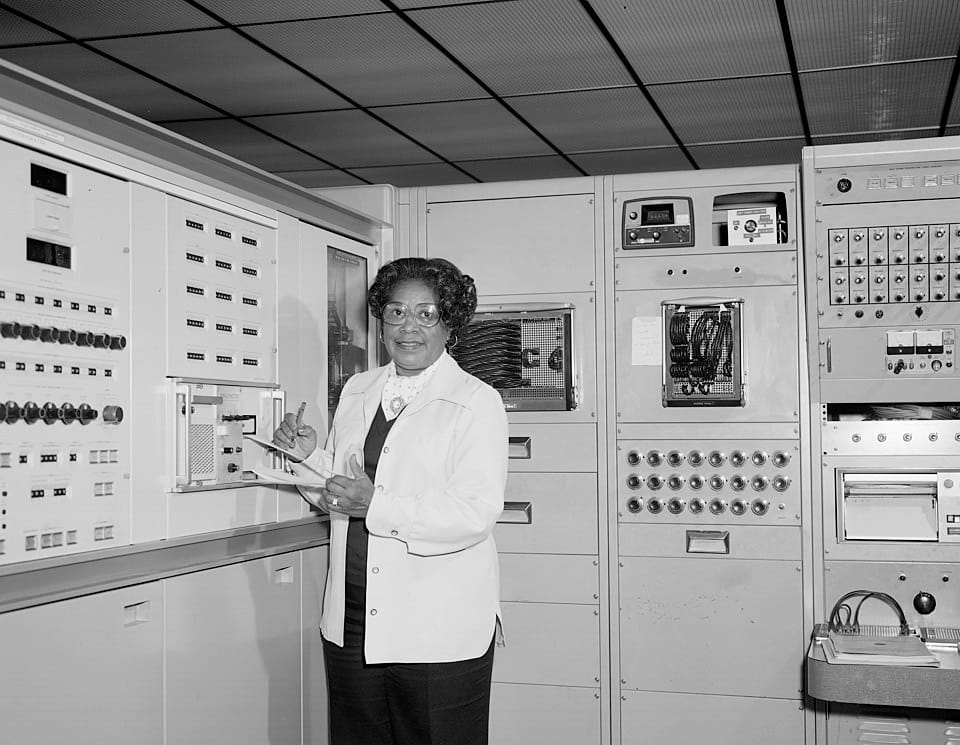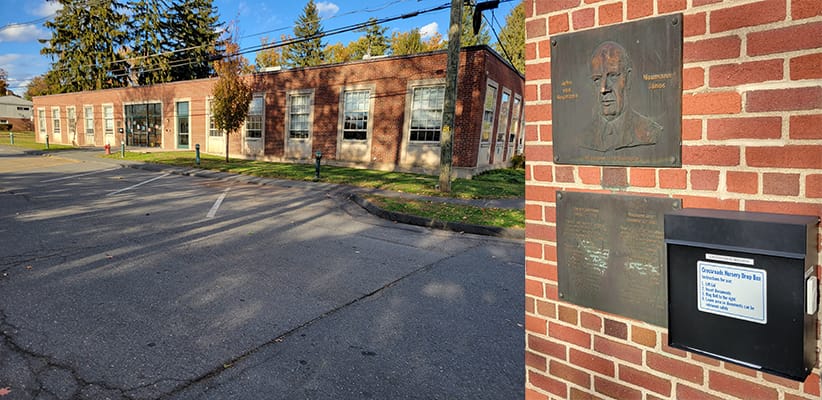computer / compute

Computer has a rather straightforward etymology, although its original meaning may be a bit surprising. The word was originally applied to people, not machines. And in the modern era before the advent of electronic computers, many of these human computers were women, as calculation was considered mundane and repetitive work, beneath the dignity of men to perform, despite the fact that such calculations were often highly complex, requiring a high degree of mathematical skill.
Computer is derived from the verb to compute + -er, a standard suffix that denotes a person that does the task of the attached verb. The verb to compute comes to us from Norman French verb computer and that in turn from the Latin computare, both meaning to calculate. The verb appears in English by the late sixteenth century. Compute can also be used as a noun meaning a calculation. This sense has a slightly different etymology, deriving directly from the Latin computus. The English noun compute is recorded about a century before the verb in reference to a computus manualis, a treatise on calculating where the church’s feast days fall on the calendar. And in Anglo-Latin, dating from the eighth century, computus could be used to refer to such chronological calculations.
We see the verb to compute used in a 1579 poem titled Incontinencye by Anthony Munday. Note that Munday is using the verb in reference to a calendrical calcuation:
If men respect their fickle date of time,
Novv in delight, then drovvnd in dark annoy.
Computing Age vvith their vnbrideled time,
Of all estates hovv brittle is their Ioy.
The noun computer, meaning a person who calculates, appears by the early seventeenth century. From Richard Braithwaite’s 1613 Yong Mans Gleanings:
What art thou (O Man) and from whence hadst thou thy beginning? What matter art thou made of, that thou promisest to thy selfe length of daies: or to thy posterity continuance. I haue read the truest computer of Times, and the best Arithmetician that euer breathed, and he reduceth thy dayes into a short number: The daies of Man are threescore and ten.
Computer was being applied to machines by the mid nineteenth century. From Phemie’s Temptation, an 1869 novel by Marian Harland (the pen name of Mary Virginia Terhune):
She despatched the change due the purchaser by Lucy Harris, the girl who had sold the lace, and plunged anew into the column of figures.
“You have offended Miss Mallory, Phemie!” the saleswoman was so ungrateful as to remark by and by, in passing. [...]
Phemie made no reply. Her pen was slowly traversing the length of the page, at an elevation of a quarter of an inch above the paper, her eyes following the course of the nib, as if it were the index of a patent computer.
The use of the modifier patent indicates that this mechanical sense is relatively new, and that readers would be accustomed to thinking of computers as people, not machines.
The use of computer to refer to a programmable, electronic, calculating machine appears shortly after World War II. The exact date is uncertain. During the war, the US and Britain had made use of calculating machines to crack Axis codes, among other uses, and the word computer was used to denote these machines. Most were mechanical apparatuses, but a few were electronic, although not yet fully programmable like a present-day electronic computer. In the early citations of the word’s use to denote an electronic machine, it’s often difficult to determine if the word is used for a mechanical or an electronic device.
For example, in 1945 mathematician John von Neumann wrote of the plans for EDVAC, one of the first electronic computers:
2.1 In analyzing the functioning of the contemplated device, certain classificatory distinctions suggest themselves immediately.
2.2. First: Since the device is primarily a computer, it will have to perform the elementary operations of arithmetic most frequently. These are addition, subtraction, multiplication and division.
Here von Neumann’s use of computer is in the sense of a mechanical computer, saying the electronic device would primarily serve the function of a mechanical device. But in 1946, Bell Labs researcher George Stiblitz wrote:
Now what kinds of problems must we expect to deal with in an automatic computer? No one person can answer this question fully, because of the enormous fields of possibilities. In general we may say that an automatic computer is best adapted to deal with repetitive problems, where many sets of data are entered into a single set of formulas, one after the other. Just how large a number is “many” and how complicated the set of formulas may be are things with depend intimately upon the design of the particular computer used. If the computer is such that new formulas are easily set up in it, it may be economical to use it in the solution of 5 or 10 problems.
Here Stiblitz is referring to a programmable, electronic device. And by 1947 the term digital computer appeared in the journal Mathematical Tables and Other Aids to Computation in reference to another early electronic computer, the IAS Machine, which was designed by von Neumann, among others:
We are engaged at the RCA Laboratories in the development of a storage tube for the inner memory of electronic digital computers. This work is a part of our collaboration with the Institute for Advanced Study in the development of a universal electronic computer.

But by 1950, computer was being used without modification, being widely understood to refer to the programmable electronic devices we’re familiar with today. From an article by Claude Shannon on the design of a computer program to play chess published in Philosophical Magazine of that year:
This paper is concerned with the problem of constructing a computing routine or “program” for a modern general purpose computer which will enable it to play chess.
Sources:
Anglo-Norman Dictionary, AND2 Phase 1 (A–E), 2000–06, s.v. computer, v., comput, n.
Braithwaite, Richard. The Yong Mans Gleanings. London: John Beale for Benjamin Lightfoote, 1614, 1. ProQuest: Early English Books Online (EEBO).
Harland, Marion (Mary Virginia Terhune). Phemie’s Temptation. New York: Carleton, 1869, 12. HathiTrust Digital Library.
Latham, Ronald E., David R. Howlett, and Richard K. Ashdowne. Dictionary of Medieval Latin from British Sources. Oxford: Oxford UP, 2013, s.v. computus, n. Brepols: Database of Latin Dictionaries.
Lewis, Charlton T. and Charles Short. A Latin Dictionary. Oxford: Oxford UP, 1879, s.v. computus, n. Brepols: Database of Latin Dictionaries.
Munday, Anthony. “Incontinencye.” The Mirrour of Mutabilitie. London: John Allde, 1579, sig. I.3v. ProQuest: Early English Books Online (EEBO).
Oxford English Dictionary Online, June 2008, s. v. computer, n., compute, v., compute, n.
Rajchman, Jan A. “Technical Developments: The Selection—A Tube for Selective Electrostatic Storage.” In Raymond Clare Archibald and Derrick Henry Lehmer, Mathematical Tables and Other Aids to Computation, 2.20, October 1947, 359–61 at 359. Archive.org. https://archive.org/details/sim_mathematics-of-computation_1947-10_2_20/page/358/mode/2up
Shannon, Claude. “Programming a Computer for Playing Chess” (8 November 1949). Philosophical Magazine: A Journal of Theoretical Experimental and Applied Physics, 41.314, March 1950, 256–75 at 256. Archive.org.
Stibitz, George. “Introduction to the Course on Electronic Digital Computers” (8 July 1946). In Martin Campbell-Kelly and Michael R. Williams, eds. The Moore School Lectures, vol. 9. Charles Babbage Institute Reprint Series for the History of Computing. Cambridge: MIT Press, 1985, 1–16 at 12.
von Neumann, John. First Draft of a Report on the EDVAC (30 June 1945). Stanford, California: Stanford University, 1992, 1. Archive.org.
Image Credits: Mary Jackson: unknown photographer / NASA, 1977. Wikimedia Commons. Public domain photo; IAS computer building: David Wilton, 2025.